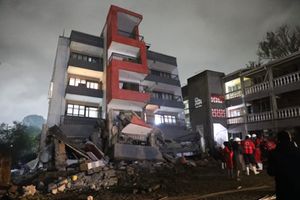Most landlords are only concerned about the profits they can rake in
Kenyan towns are fast expanding to meet the needs of a steadily increasing population.
And the housing choices of many Kenyans show that they put a high premium on accessibility to lifestyle opportunities, which are most likely to be centered around urban areas.
This has led to a growth in urban population, thus creating an insatiable thirst for housing. Indeed, the Ministry of Housing estimates the current housing deficit to be between 200,000 and 250,000 units a year.
Demand for housing in urban areas is so high that developers are almost assured that whatever they put up will be taken up. To meet the demand, developers work hard to put up buildings as fast as possible with little or no regard for quality.
A look at residential buildings in the country leaves one worried about the conditions Kenyans have to put up as they seek shelter.
There are more and more poorly designed houses whose price and rent keep soaring. Many Kenyans have little or no choice but to accept them.
The highrise concrete houses that are characteristic of Kenyan urban centres have little consideration for the needs of a household.
LITTLE NATURAL LIGHTING
Common in most buildings is a lack of consideration for natural lighting. The importance of natural light in a house cannot be understated.
It not only reduces energy costs and improves the appearance of the home, it also affects the health and mental wellbeing of the occupants. It is, therefore, shocking to find houses fitted with tiny windows, some the size of an average pillow cushion.
The houses are also built close to one another, which significantly increases the amount of shadow cast on the windows or doors to habitable rooms.
It is also not uncommon to find bedrooms with no windows. Such houses will normally use excess energy as it is normally necessary to have the lights on throughout the day.
To demonstrate how important lighting is in a house, scientists say that lack of natural light can lead to a weakened immune system, premature ageing, and disrupted sleeping patterns. More natural light is said to decrease the risk of insomnia and depression.
Also common are buildings with many apartments along a single corridor. Many buildings also fail to consider spaces for children and have no wheelchair access, let alone adequate emergency exits in case of fire.
The temptation to maximise profits has led to the construction of smaller units which take less space. The houses are, therefore, small, cramped spaces with kitchens that may be located in hallways or take no more than 1.5 square metres.
PACKED BALCONIES
The houses also lack adequate storage space. Is it not always an eyesore to see houses with balconies packed with all sorts of stuff, including mattresses, water tanks and jerricans, and empty cartons. It is not unusual to find water from wet laundry dripping on the whole pile.
Some of the buildings are not only ugly and uncomfortable, they are downright unhealthy. Lack of ventilation and lighting makes them a perfect breeding ground for disease-causing rodents and insects like mosquitoes. Cockroaches thrive in these ill-planned houses.
Poor quality of housing and its design is also associated with a higher risk of airborne infectious disease transmission, respiratory and cardiovascular diseases including tuberculosis, as well as the accumulation of indoor pollutants which, according to the World Health Organisation, kill approximately two million people in the developing world annually.
The risk of home injuries is also high in poorly designed houses. Picture a house with such a low ceiling that a “mind your head” sign is necessary. Or a house that uses wall tiles on the floor, significantly increasing the risk of slips and falls.
Ventilation is also a much ignored element in most of the poorly planned houses. Ventilation plays a crucial role in one’s enjoyment of a house as it makes it considerably more pleasant, healthy, and comfortable.
A properly designed house ventilation system will help remove cooking smells, allergens, and other irritants such as tobacco or smoke from cooking stoves.
SMOKE SETTLES ON WALLS
Many Kenyans use kerosene and charcoal stoves. The smoke that comes from these cookers needs to have an outlet, otherwise it will not only make the house smelly, the smoke will also settle on the walls, making the house not only dark and unpleasant, but also ultimately unhealthy.
The lower floors, and particularly the ground floor, of the cramped, highrise buildings are the most affected by lack of ventilation and will usually be damp and humid, contributing to the development of allergies, asthma, and other respiratory tract diseases.
The humidity levels are not helped by the fact that the tiny spaces between houses are occupied by clothes lines, which often have dripping laundry.
This, coupled with the fact that the verandas are usually made from hard, impermeable concrete, which reduces natural drainage on the site, ensures that the ground floor is always wet. In some cases, the space above the veranda is also enclosed by a roof.
This way, the moisture has no way of getting out. This wetness is passed on to the walls and it is not unusual to find mould growing on the ground floor walls.
In addition, problems such as dampness, mould, structural defects present in poorly designed houses increase the risk of buildings collapsing.
Some of the houses may give the illusion of being big because they have many bedrooms. Rent in most Kenyan houses is determined by the number of bedrooms.
UNLIVABLE SLUM
This encourages developers to create tiny houses but with many bedrooms in order to maximise the amount of revenue they can collect.
One cannot help wondering who designs these buildings and if the designers derive any pride from being associated with them. There must be a way to create proper housing developments without having to pack people like sardines in small unsanitary spaces.
There is no question that there is a great need for housing. However, we must be careful not to turn every house we construct into tomorrow’s unsalable, unlivable slum.
Sadly, unless builders and designers put — or are forced to put — people’s needs at the heart of planning and designing, it is a real and imminent danger.
Tougher legislation
For the sake of human dignity, it might be necessary to introduce tougher legislation regulating minimum building standards.
Perhaps regulations dictating how apartments should be designed and a minimum size is necessary. Such regulations would force developers and designers to deliver appropriate quality and amenity standards.
While some might argue that developers dictate the design, it is wrong for designers to support the short-sighted goals of developers who ignore people’s needs by failing to factor in crucial aspects of living, and who only care about the money they can make from such buildings.
Without minimum standards, developers will always prefer to contract malleable architects who are willing to indulge their whims instead of professionals who insist on accepted standards.
MINIMUM FLOOR SPACE
For every designer who will not work with them, there are probably two others who will. Eventually, the professional ones might be forced to bow to the pressure and join the trend of poor quality housing.
There would be a challenge implementing new regulations as the authorities responsible seem to be unable or unwilling, to enforce the existing ones.
There is a general lack of commitment to implementing regulations and developers take advantage of that. The overriding criteria for design approval among most county authorities seems to be maximising the levies they can collect from the development.
It is understandable that developers would have to tackle the issue of delivering quality while maintaining affordability and would, thus, be less receptive to such regulation.
However, providing affordable housing does not have to equal seedy and insanitary.
It would be better if they could be made to adhere to set benchmarks to ensure that they provide minimum floor space, natural and controllable ventilation, and adequate flow of natural light, storage space, and ceiling height.
In addition, part of the solution to cramped houses would be to sell property by the square foot rather than the number of bedrooms. Then developers would not have to squeeze in as many bedrooms as possible with the aim of creating the illusion of a larger home.
POOR QUALITY
The downside is that most of these houses are also highly priced compared to the value they offer. Take, for example, a one-bedroom house of roughly 30 square metres or less with all the above-mentioned characteristics of poor design in Nairobi.
It will fetch between Sh7,000 and Sh15,000 monthly in rent. The developer gets a good return compared to cost, thus the incentive to improve quality is lost.
The wealthier section of the population is covered by well-designed luxury apartments and can also afford to build their own houses.
However, most Kenyans cannot afford to own a house and do not qualify for mortgage. They have to rent and are, therefore, at the mercy of unscrupulous developers.
Without strictly enforced standards, developers and property investors get away with providing poor quality or inadequate space in their properties.
Many industry players are not likely to be receptive to such legislation. This is mainly because they are in the business solely for the profit they can make.
Housing, a basic human need, should not be reduced to a purely profit-making venture. Poor housing erodes the edge of our towns as attractive, livable locations.
Whether we are aware of it or not, the design of houses has social and economic impacts which should not be ignored.
FLASHY LOOKING
The public has an important role to play in setting benchmarks to ensure that developers do not continue to build unsanitary spaces. Indeed, the most worrying trend with regard to housing in Kenya is the lack of public concern, debate, controversy, or concern over poor housing conditions.
While builders and designers are partly to blame for the mess in the housing sector, the public should also accept its share of the blame for encouraging the trend to continue. As long as people are willing to pay rent for a poorly designed house, the developers will continue to construct such buildings.
The public and the authorities that represent it seem to be ignorant about what is happening. We seem to be oblivious to the long-term costs of the present-day delights of the new flashy looking but unsanitary developments coming up everywhere around us.
With very little attention to proper housing design, too many greedy investors, and a complacent public, we are all actively participating in developing the slums of the future.
They might be sophisticated with tiled walls and floors, have water and electricity, but are unsanitary, unsafe, and unfit for human habitation. In essence, they will in future become sophisticated slums.
There is definitely a need for foresight and better public-private engagement in housing decisions. The authorities concerned should propose a coherent and all-encompassing plan including the introduction of minimum building standards. If we do not act now, we will have failed the present and future generations.




